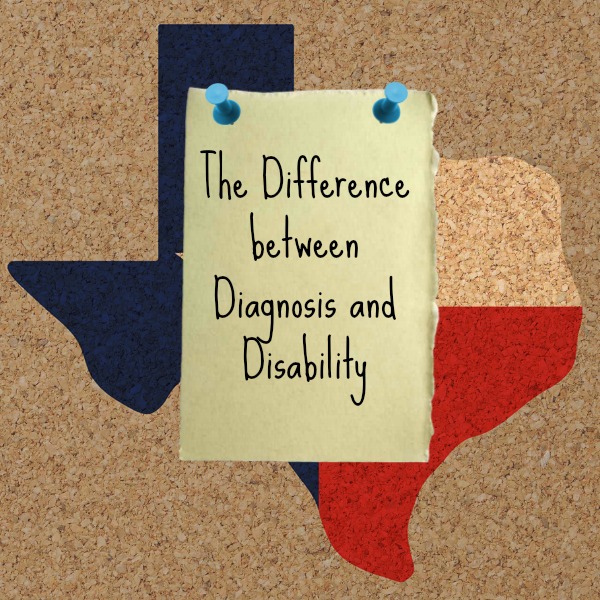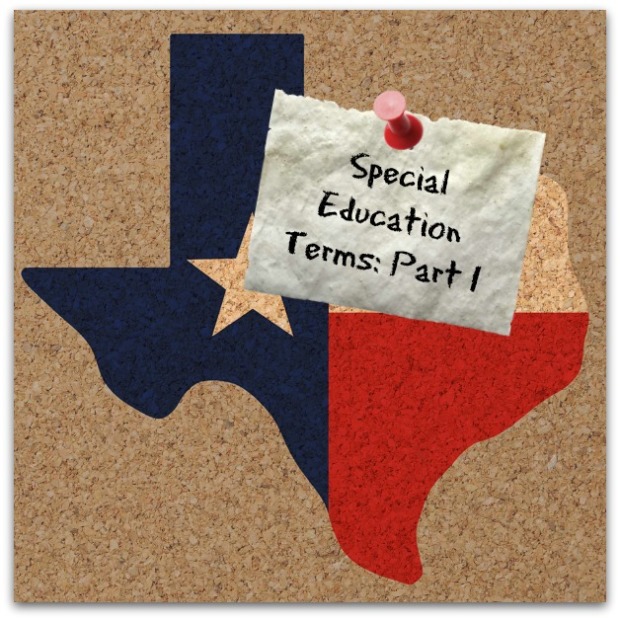Special Education in Texas: The Difference between Diagnosis and Disability
 This is a confusing point of Special Education for many teachers and parents. Students may be diagnosed by a doctor outside of school as having a certain diagnosis, however students may only qualify for Special Education services if they fall under one of the disability categories set forth by the Individuals with Disabilities Education Act, or IDEA. Moreover, each state has the ability to define those categories as they see fit, as long as they retain the key elements of IDEA.
This is a confusing point of Special Education for many teachers and parents. Students may be diagnosed by a doctor outside of school as having a certain diagnosis, however students may only qualify for Special Education services if they fall under one of the disability categories set forth by the Individuals with Disabilities Education Act, or IDEA. Moreover, each state has the ability to define those categories as they see fit, as long as they retain the key elements of IDEA.
The federal law (IDEA) uses the following terms to define a “child with a disability”:
- Autism,
- Deaf-blindness,
- Deafness,
- Emotional disturbance,
- A hearing impairment,
- Intellectual Disability,
- An orthopedic impairment,
- Other health impairment,
- A specific learning disability,
- A speech or language impairment,
- Traumatic brain injury,
- A visual impairment including blindness, or
- Multiple disabilities.
Texas uses the following list of disability categories to determine if a student (aged 3-21) is eligible for special education and related services:
- Auditory Impairment (AI)
- Autism (AU)
- Deaf-Blindness (DB)
- Emotional Disturbance (ED)
- Intellectual Disability (ID) (formerly called Mental Retardation)
- Multiple Disabilities (MD)
- Orthopedic Impairment (OI)
- Other Health Impairment (OHI)
- Learning Disability (LD)
- Speech Impairment (SI)
- Traumatic Brain Injury (TBI)
- Visual Impairment (VI)
- Non-Categorical Early Childhood (NCEC)
Disability is determined through evaluation by a licensed school psychologist, and accepted by a committee that includes the student’s parent or legal guardian during the initial Admission, Review and Dismissal committee meeting. If a child doesn’t qualify for Special Education services, they may still be eligible for services to be provided under Section 504 of the Rehabilitation Act of 1973 to ensure that their individual educational needs are met as adequately as those of non-disabled students.
Texas Special Education Terms: Part 1
“Make sure that you base your IEP on the TEKS, and don’t forget about OT/PT.”
If you have ever listened to a group of Special Education teachers for any length of time, you might start to wonder if they developed their own language. Special Education terms can vary by state, or even between districts. It’s not always easy to keep everything straight, so I have put together a short list of commonly used Special Education terms that I thought might be helpful for teachers, parents, or anyone interested in finding out more about Special Education. I will post new terms as the year goes on. Here are a handful of terms to get you started.
- ARD – These letters stand for Admission, Review, and Dismissal. The purpose of the ARD meeting is to provide an opportunity for parents and educators to discuss and develop an educational program for the student (the I.E.P.) The ARD must take place at least once each school year, although it can happen anytime decisions about the student need to be made. The group of people who make educational decisions about the student are known as the ARD committee. Participants in this committee can include, but are not limited to: the student, parents and/or legal guardians, the student’s case manager, the Special Education coordinator, general education teachers that work directly with the student, speech therapists, occupational therapists, physical therapists, parent advocates, and social workers.
- IEP – Individual Education Plan. This is the legal written document developed for an individual identified as having a disability according to IDEA. It is the written plan that details the student’s present level of academic achievement and functional performance (PLAAF), results of state and district-wide assessments, transition plan (begins at age 15the special education goals, services and related services that are to be provided to the individual student. Parents and school staff work together to develop the IEP at the ARD meeting. The IEP must be reviewed at least annually.
- SPED or Spec. Ed. – Special Education. Special Education services are provided at no cost to parents, to meet the unique needs of a child with a disability, including instruction conducted in the classroom, in the home, in hospitals and institutions, and in other settings; and instruction in physical education. This term may be used in reference to the “SPED teacher” or “SPED Department”. Best practice is moving away from this term, especially when used to refer to “SPED students”. It is more appropriate to use person first language, such as ‘students with Special Education needs’ or ‘student receiving Special Education services’. TEA provides an excellent side-by-side comparison of federal regulations, the Commissioner’s/SBOE Rules, and Texas state laws.
- Gen. Ed. – General Education. The general education classroom and curriculum. In Texas the general education curriculum is the Texas Essential Knowledge and Skills, or the TEKS.
- IDEA – Individuals with Disabilities Education Act, also known as Public Law 94-142. First passed in 1975, this law established the right of school-age students with disabilities to receive “free appropriate public education”, also known as FAPE. The law was amended in 1996 to include preschool-aged children with disabilities ages three through five. Essentially, this law provides the minimum requirements each state must meet in order to receive federal special education funds.
- LRE – Lease Restrictive Environment. A legal mandate of the Individuals with Disabilities Education Act, IDEA, this term refers to the right of every student to be educated with non-disabled peers to the maximum extent appropriate. This is one of the most controversial terms in the IDEA law. Texas interprets the Least Restrictive Environment to be the general education classroom. Clear documentation of the discussion leading up to the decision and the outcome of the discussion must be placed in the student’s IEP if the ARD committee determines that the student will not participate in the general education classroom and/or curriculum for all or part of the day.
Let me know what terms you would like to see defined, and be sure to like my page on Facebook and share with other middle school teachers! Thanks!
New Teacher To-Do List for Special Education Teachers
If you are a special education teacher, the beginning of your year looks a little differently than it does for the content area teachers. Unless you are teaching an intervention class, you probably don’t have a room to prepare and you aren’t busy thinking about lesson plans. It can feel like there really isn’t anything to do except get your office organized and wait to meet your students. At least that is how I felt my first year. I didn’t know where to start.
While there is an element of waiting involved because you need to assess the students on your caseload before you can really begin any intervention, there are some things you can be working on during those teacher workdays to get yourself ahead of the game.
1. Get your caseload. First things first: you need to know who your students are before you can really start doing much of anything. Your Special Education coordinator should have this information, more or less, by the start of the school year. There are always little last minute changes, but you should have a solid list by the time you show up for teacher workdays.
2. Make student files/folders. I like to have one manila folder to keep each student’s important data. Don’t make it complicated, or you won’t use it.
3. Figure out your student’s class schedules. This is also a good thing to staple onto the front your student folder, and stick a copy in your teacher binder. This comes in handy when you are trying to locate students for progress monitoring.
4. Create your teacher information binder.
5. Write a letter to parents, introducing yourself as their child’s case manager. It’s good to make that first connection early. Starting out on the right foot with parents will set your year up for success. Open communication between parents and teachers is essential when it comes to helping your students meet their IEP goals for the year.
6. Familiarize yourself with your student’s IEP and MDT information. This is a great way to get to know your students before you meet them. You can learn their strengths, what they worked on last year, and most importantly their goals for the upcoming year. It is also a good idea to note if you have any yearly review meetings right of the bat, so you can get everything in order. **More on that in a future post!**
7. Locate the assessment materials you will need for progress monitoring. Sometimes these can be hidden away in a book closet, or have been unintentionally hoarded by another teacher (gasp!). Ask around. Find out what your school and your district approves for math, reading, and writing probes. You will probably receive some information about this at new teacher orientation. You will want these materials ready to go in the first couple weeks so that you can assess where your students are at, and use the assessments to begin working on strategies with them.
7. Introduce yourself to your co-teachers, and schedule a time to plan together. Take the initiative and get this relationship off to the best start. A great co-teaching relationship can be a wonderful experience, but an poor one can make your year seem 18 months long. Show your co-teacher that you are ready and willing to jump in and be by his/her side, not standing in the back of the room.
Hopefully, this will help new Special Education teachers figure out where to start on those first few days. Don’t worry, once the year gets going, you won’t have any trouble finding things to do!!













